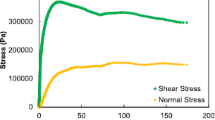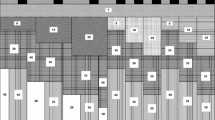Abstract
This paper presents the results of a study to evaluate the fatigue performance of pavements that contain RAP materials. The study is based on two different accelerated loading tests conducted in the United States. Each of these two projects has corresponding pavements with and without RAP mixtures that were constructed over the same aggregate base and subgrade and subjected to the same traffic loading and environmental conditions. The primary reason for selecting these two projects is that they exhibited opposite trends in a comparison of the fatigue cracking performance of their pavements with and without RAP. The asphalt mixtures in the test pavements were characterized using the simplified viscoelastic continuum damage model. The fatigue cracking performance of the pavements was then modeled using the characterized material properties, in situ pavement structures and traffic loads, and climate conditions in FlexPAVE™, a three-dimensional layered viscoelastic finite element program with moving load analysis. The resultant fatigue cracking performance predictions matched the field observations well. Both the simulation results and the field observations also showed that the fatigue cracking performance of the asphalt mixtures that
Similar content being viewed by others
References
Asphalt Pavement Alliance (APA) (2001a). Recycling Asphalt Pavement Background. Paper posted on the APA website (http://www. asphaltalliance.com) as a.pdf file. Accessed 6 November 2001.
Chehab, G. R., Kim, Y. R., Schapery, R. A., Witczack, M., and Bonaquist, R. (2003). “Characterization of asphalt concrete in uniaxial tension using a viscoelastoplastic model.” Journal of the Association of Asphalt Paving Technology, vol. 72, pp. 315–355.
Daniel, J. S. and Kim, Y. R. (2002). “Development of a simplified fatigue test and analysis procedure using a viscoelastic continuum damage model.” Journal of the Association of Asphalt Paving Technologists, vol. 71, pp. 619–650.
Eslaminia, M. and Guddati, M. N. (2016). “Fourier-finite element analysis of pavements under moving vehicular loading.” International Journal of Pavement Engineering, vol. 17, pp. 602–614, DOI: 10.1080/10298436.2015.1007237.
Eslaminia, M., Thirunavukkarasu, S., Guddati, M. N., and Kim, Y. R. (2012). “Accelerated pavement performance modeling using layered viscoelastic analysis.” Proceedings of the 7th International RILEM Conference on Cracking in Pavements, Delft, Netherlands, pp. 20–22.
Kim, Y. R. and Little, D. N. (1990). “One-dimensional constitutive modeling of asphalt concrete.” ASCE Journal of Engineering Mechanics, vol. 116, no. 4, pp. 751–772, DOI: 10.1061/(ASCE)0733-9399(1990)116:4(751).
Kim, Y. R., Guddati, M. N., Choi, Y. T., Kim, D., Norouzi, A., Wang, Y., Keshavarzi, B., Ashouri, M., and Wargo, A. D. (2017). Development of Asphalt Mixture Performance-Related Specifications. Final report, Contract No. DTFH61-08-H-00005, North Carolina State University, Raleigh, NC.
Sabouri, M., Bennert, T., Daniel, J. S., and Kim, Y. R. (2015a). “A comprehensive evaluation of the fatigue behavior of plant-produced RAP mixtures.” Journal of Road Materials and Pavement Design, vol. 16, no. 2, pp. 29–54, DOI: 10.1080/14680629.2015.1076997.
Sabouri, M., Bennert, T., Daniel, J. S., and Kim, Y. R. (2015b). “Fatigue and rutting evaluation of laboratory-produced asphalt mixtures containing reclaimed asphalt pavement.” Transportation Research Record: Journal of the Transportation Research Board, no. 2506, pp. 32–44, DOI: 10.3141/2506-04.
Underwood, B. S., Baek, C., and Kim, Y. R. (2012). “Simplified viscoelastic continuum damage model as platform for asphalt concrete fatigue analysis.” Transportation Research Record: Journal of the Transportation Research Board, no. 2296, pp. 35–45, DOI: 10.3141/2296-04.
Underwood, B. S., Kim, Y. R., and Guddati, M. N. (2006). “Characterization and performance prediction of ALF mixtures using a viscoelastoplastic continuum damage model.” Journal of the Association of Asphalt Paving Technologists, vol. 75, pp. 577–636.
Wang, Y. and Kim, Y. R. (2017a). “Development of a pseudo strain energybased fatigue failure criterion for asphalt mixtures.” International Journal of Pavement Engineering, DOI: 10.1080/10298436.2017. 1394100.
Wang, Y. and Kim, Y. R. (2018). “Development of a simple fatigue index parameter for asphalt concrete based on the viscoelastic continuum damage theory.” Journal of Association of Asphalt Paving Technologies, accepted.
Wang, Y., Keshavarzi, B., and Kim, Y. R. (2018). “Fatigue Performance predictions of asphalt pavements using FlexPAVETM with the SVECD model and DR failure criterion.” Transportation Research Record: Journal of the Transportation Research Board, Transportation Research Board of the National Academies, Washington, D.C., DOI: 10.1177/0361198118756873.
Wang, Y., Norouzi, A. H., and Kim, Y. R. (2016). “Comparison of fatigue cracking performance of asphalt pavements predicted by pavement ME and LVECD Programs.” Transportation Research Record: Journal of the Transportation Research Board, No. 2590, Transportation Research Board of the National Academies, Washington, D.C., pp. 44–55, DOI: 10.3141/2590-06.
Author information
Authors and Affiliations
Corresponding author
Rights and permissions
About this article
Cite this article
Wang, Y.D., Keshavarzi, B. & Kim, Y.R. Fatigue Performance Analysis of Pavements with RAP Using Viscoelastic Continuum Damage Theory. KSCE J Civ Eng 22, 2118–2125 (2018). https://doi.org/10.1007/s12205-018-2648-0
Received:
Revised:
Accepted:
Published:
Issue Date:
DOI: https://doi.org/10.1007/s12205-018-2648-0




